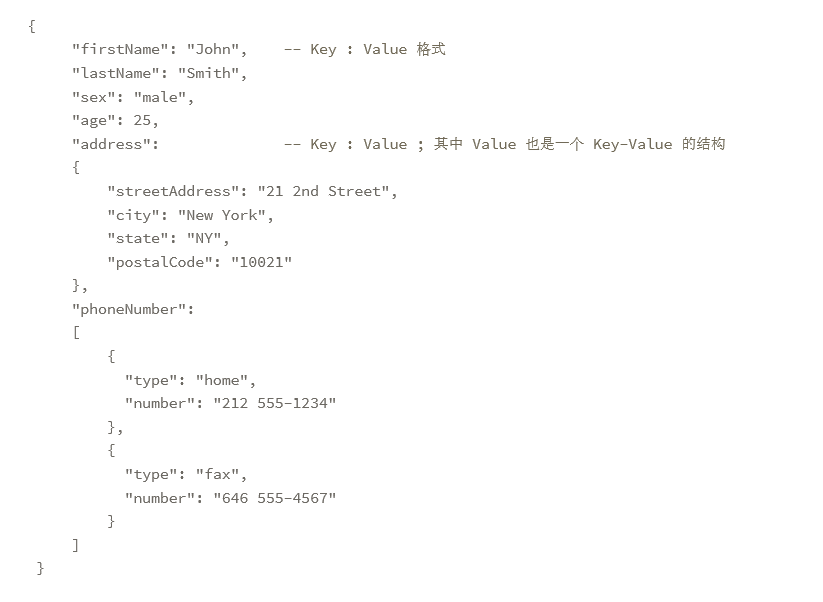Mysql json類型
5.7版本支持
原生json類型代替BLOB類型
json數據有效性檢查
查詢性能提升:不需要遍歷所有字符串才能找到數據
支持部分屬性索引
1. json格式範例
2. 結構化與非結構化
結構化:二維表結構(行和列) ◦ 使用SQL語句進行操作
非結構化:使用Key-Value格式定義數據,無結構定義 ◦ Value可以嵌套Key-Value格式的數據 ◦ 使用JSON進行實現
SQL創建User表
create table user (
id bigint not null auto_increment,
user_name varchar(10),
age int,
primary key(id) );
JSON定義的User表 ==類似mongodb文檔數據庫
db.user.insert({ user_name:"tom", age:30 })
db.createCollection("user")
3. json 操作例子
(1)json入門
創建帶json字段的表
create table user (
uid int auto_increment,
data json,
primary key(uid));
插入json數據
insert into user values(
null,
'{"name":"tom",
"age":18,
"address":"sz"
}'
);
"root@localhost:mysql.sock [json]>select * from user;
+-----+---------------------------------------------+
| uid | data |
+-----+---------------------------------------------+
| 1 | {"age": 18, "name": "tom", "address": "sz"} |
+-----+---------------------------------------------+
1 row in set (0.01 sec)
insert into user values("age":28,
"mail":"[email protected]"
br/>null,
'{"name":"jim",
"age":28,
"mail":"[email protected]"
}'
);
insert into user values ( null, "can you insert it?");
4、json常用函數介紹
(1)json_extract
使用json_extract提取數據
原型 : JSON_EXTRACT(json_doc, path[, path] ...)
從list中抽取 下標 爲1的元素(下標從0開始)
select json_extract('[10, 20, [30, 40]]', '$[1]');
"root@localhost:mysql.sock [json]>select json_extract('[10, 20, [30, 40]]', '$[1]');
+--------------------------------------------+
| json_extract('[10, 20, [30, 40]]', '$[1]') |
+--------------------------------------------+
| 20 |
+--------------------------------------------+
1 row in set (0.00 sec)
select json_extract(data, '$.name'),json_extract(data, '$.address')from user;
"root@localhost:mysql.sock [json]>select json_extract(data, '$.name'),json_extract(data, '$.address')from user;
+------------------------------+---------------------------------+
| json_extract(data, '$.name') | json_extract(data, '$.address') |
+------------------------------+---------------------------------+
| "tom" | "sz" |
| "jim" | NULL |
+------------------------------+---------------------------------+
2 rows in set (0.00 sec)
(2)json_object
將list(K-V對)封裝成json格式
原型 : JSON_OBJECT([key, val[, key, val] ...])
select json_object("name", "jery", "email", "[email protected]", "age",33);
"root@localhost:mysql.sock [json]>select json_object("name", "jery", "email", "[email protected]", "age",33);
+----------------------------------------------------------------+
| json_object("name", "jery", "email", "[email protected]", "age",33) |
+----------------------------------------------------------------+
| {"age": 33, "name": "jery", "email": "[email protected]"} |
+----------------------------------------------------------------+
1 row in set (0.00 sec)
insert into user values (
null,
json_object("name", "jery", "email", "[email protected]", "age",33)
);
(3)json_insert
插入數據
原型 : JSON_INSERT(json_doc, path, val[, path, val] ...)
set @j = '{ "a": 1, "b": [2, 3]}';
select json_insert(@j, '$.a', 10, '$.c', '[true, false]');
"root@localhost:mysql.sock [json]>select json_insert(@j, '$.a', 10, '$.c', '[true, false]');
+----------------------------------------------------+
| json_insert(@j, '$.a', 10, '$.c', '[true, false]') |
+----------------------------------------------------+
| {"a": 1, "b": [2, 3], "c": "[true, false]"} |
+----------------------------------------------------+
1 row in set (0.00 sec)
update user set data = json_insert(data, "$.address_2", "BJ") where uid = 1;
select * from user;
(4)json_merge
合併數據並返回。注意:原數據不受影響
原型 : JSON_MERGE(json_doc, json_doc[, json_doc] ...)
-- 原來有兩個JSON
select json_merge('{"name": "x"}', '{"id": 47}');
"root@localhost:mysql.sock [json]>select json_merge('{"name": "x"}', '{"id": 47}');
+-------------------------------------------+
| json_merge('{"name": "x"}', '{"id": 47}') |
+-------------------------------------------+
| {"id": 47, "name": "x"} |
+-------------------------------------------+
1 row in set (0.00 sec)
(5)json_array_append
追加數據 --
原型 : JSON_ARRAY_APPEND(json_doc, path, val[, path, val] ...)
-- json_append 在5.7.9 中重命名爲 json_array_append
set @j = '["a", ["b", "c"], "d"]'; -- 下標爲1的元素中只有["b", "c"]
select json_array_append(@j, '$[1]', 1);
"root@localhost:mysql.sock [json]>select json_array_append(@j, '$[1]', 1);
+----------------------------------+
| json_array_append(@j, '$[1]', 1) |
+----------------------------------+
| ["a", ["b", "c", 1], "d"] |
+----------------------------------+
1 row in set (0.00 sec)
(6)json_remove
從json記錄中刪除數據
-- 原型 : JSON_REMOVE(json_doc, path[, path] ...)
set @j = '["a", ["b", "c"], "d"]';
select json_remove(@j, '$[1]');
update user set data = json_remove(data, "$.address_2") where uid = 1;
5. json創建索引
JSON 類型數據本身 無法直接 創建索引,
需要將需要索引的JSON數據重新生成虛擬列(Virtual Columns) 之後,對該列進行索引
(1)新建表時創建JSON索引
#抽取data中的name, 生成新的一列,名字爲gen_col並將gen_col 作爲索引
create table test_inex_1(
data json,
gen_col varchar(10) generated always as (json_extract(data, '$.name')),
index idx (gen_col)
);
show create table test_inex_1;
"root@localhost:mysql.sock [json]>show create table test_inex_1\G;
1. row
Table: test_inex_1
Create Table: CREATE TABLE test_inex_1 (data json DEFAULT NULL,gen_col varchar(10) GENERATED ALWAYS AS (json_extract(data,'$.name')) VIRTUAL,
KEY idx (gen_col)
) ENGINE=InnoDB DEFAULT CHARSET=utf8mb4
1 row in set (0.00 sec)
insert into test_inex_1(data) values ('{"name":"tom", "age":18, "address":"SH"}');
insert into test_inex_1(data) values ('{"name":"jim", "age":28, "address":"SZ"}');
select * from test_inex_1;
"root@localhost:mysql.sock [json]>select * from test_inex_1;
+---------------------------------------------+---------+
| data | gen_col |
+---------------------------------------------+---------+
| {"age": 18, "name": "tom", "address": "SH"} | "tom" |
| {"age": 28, "name": "jim", "address": "SZ"} | "jim" |
+---------------------------------------------+---------+
2 rows in set (0.00 sec)
select json_extract(data,"$.name") as username from test_inex_1 where gen_col='"tom"'; -- 使用'"tome"',用單引號括起來
explain select json_extract(data,"$.name") as username from test_inex_1 where gen_col='"tom"'\G
(2)修改已存在的表創建JSON索引
show create table user;
select from user;
alter table user add user_name varchar(32) generated always as (json_extract(data,"$.name")) virtual;
select user_name from user;
alter table user add index idx(user_name);
select from user where user_name='"tom"'; -- 加單引號
explain select * from user where user_name='"tom"'\G
6. 附錄
-- 老師演示JSON的SQL
-drop table if exists User;
CREATE TABLE User (
uid BIGINT NOT NULL AUTO_INCREMENT PRIMARY KEY,
name VARCHAR(32) NOT NULL,
email VARCHAR(256) NOT NULL,
address VARCHAR(512) NOT NULL,
UNIQUE KEY (name),
UNIQUE KEY (email) );
INSERT INTO User VALUES (NULL,'David','david@gmail','Shanghai ...'); INSERT INTO User VALUES (NULL,'Amy','amy@gmail','Beijing ...');
INSERT INTO User VALUES (NULL,'Tom','tom@gmail','Guangzhou ...');
SELECT * FROM User;
ALTER TABLE User ADD COLUMN address2 VARCHAR(512) NOT NULL; ALTER TABLE User ADD COLUMN passport VARCHAR(64) NOT NULL;
DROP TABLE IF EXISTS UserJson;
CREATE TABLE UserJson(
uid BIGINT NOT NULL AUTO_INCREMENT PRIMARY KEY,
data JSON );
truncate table UserJson;
insert into UserJson SELECT uid,JSON_OBJECT('name',name,'email',email,'address',address) AS data FROM User;
SELECT * FROM UserJson;
SELECT uid,JSON_EXTRACT(data,'$.address2') from UserJson;
UPDATE UserJson set data = json_insert(data,"$.address2","HangZhou ...") where uid = 1;
SELECT JSON_EXTRACT(data,'$.address[1]') from UserJson;
select json_merge(JSON_EXTRACT(data,'$.address') ,JSON_EXTRACT(data,'$.address2')) from UserJson;
begin;
UPDATE UserJson set data = json_array_append(data,"$.address",JSON_EXTRACT(data,'$.address2')) where JSON_EXTRACT(data,'$.address2') IS NOT NULL AND uid >0;
select JSON_EXTRACT(data,'$.address') from UserJson;
UPDATE UserJson set data = JSON_REMOVE(data,'$.address2') where uid>0;
commit;

